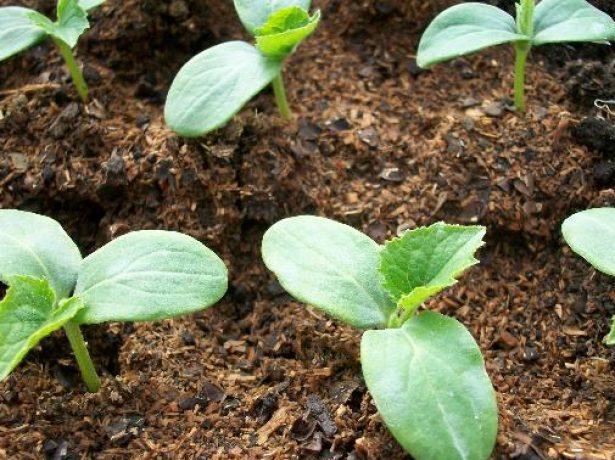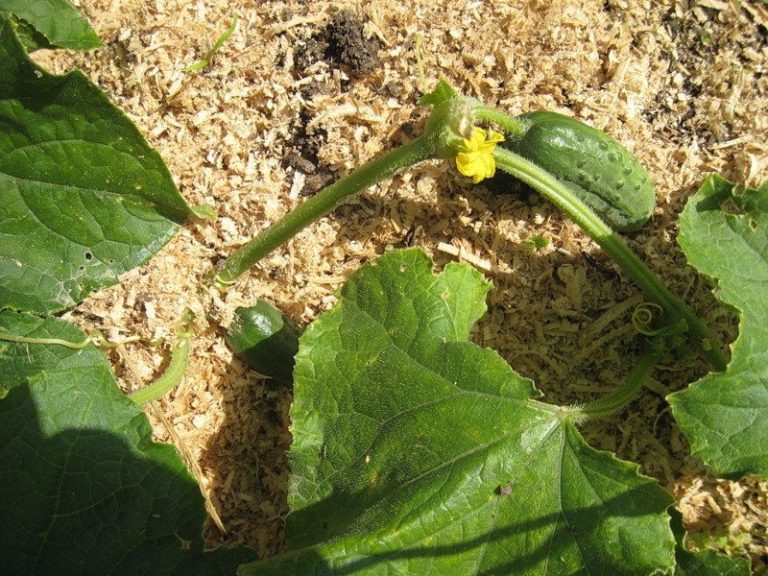
Sawdust cucumbers: growing seedlings using Japanese technology
Cucumbers are deservedly considered rather capricious and tender plants, negatively reacting even to minor flaws in agricultural technology and deviations from optimal growing conditions. Seedlings are especially sensitive in this regard. Therefore, gardeners are constantly inventing new methods to increase its resistance and quickly get healthy, powerful and developed seedlings. Popular, for example, Japanese technology, involving the planting of seeds in a special substrate - sawdust.
Japanese method of growing cucumbers: a general description, advantages and disadvantages
The main "trick" of the Japanese technology for growing cucumber seedlings is the use of sawdust instead of the usual substrate. In the same way, seeds of other Pumpkin seeds can be planted - in seedlings of zucchini, squash, melons, watermelons, pumpkins, a delicate root system that is easy to damage during transplantation.Landing in sawdust allows you to transfer them to the ground so that the roots do not suffer.
Cucumber seedlings grown in ordinary soil, when transported to the garden, are experiencing severe stress, losing a significant part of the root system
Advantages of the technique:
- Earlier harvest ripening. Cucumbers are planted in sawdust spilled with hot water. They retain heat better than ordinary earth. Thus, the seeds are provided with a “greenhouse effect” for a long time, seedlings appear faster, are more actively moving in growth, there are no delays in seedling development. Ready seedlings can be transferred earlier to the garden.On average, crops begin to be harvested 15–20 days earlier than when planting seeds in open ground.
- Minimizing the risk of disease. Ordinary soil may contain spores of pathogenic fungi, weed seeds, eggs and pest larvae. Also, on cucumbers during overflow, root or gray rot is almost inevitably formed. Sawdust is more water-absorbing than the "classic" substrate, seedlings can be watered less often.
- More "clean" process of planting seeds for seedlings. Ordinary soil smudges the floor, table, windowsill, other surface on which the seeds are planted. Scattered sawdust is much easier and faster to remove.
- Preservation of the root system of seedlings of cucumbers when transplanting into the beds. Sawdust is very loose, the plants are easy to remove from the tank and simply “shake off” the remains of the substrate from the roots. If you do this with ordinary soil, up to 50% of the root system will remain in it. Accordingly, when planting according to Japanese technology, the percentage of cucumbers that do not survive transplanting in the garden is significantly reduced, plants need less time to adapt to a new habitat. There is no need to repair damaged roots, seedlings move faster.
- Saving space on the windowsill. Since picking is not recommended for cucumber seedlings, they immediately have to be planted in individual containers that take up a lot of space. Seedlings in sawdust can be grown in one common container, there are no problems with extracting individual seedlings from the substrate.
- Improved aeration. Sawdust is much better than soil, allowing air to pass through. The flow of oxygen to the roots of seedlings is necessary for their normal development. Sawdust, unlike soil, there is no need to loosen after watering, preventing "compaction". Accordingly, there is no risk of damaging the roots during cultivation.
- Building a more powerful root system. Due to good aeration, "airiness", friability of the substrate and the absence of damage during transplantation. In the future, developed roots draw more nutrients from the soil and can “feed” a larger number of ovaries - increasing productivity.
A powerful and developed root system of plants provides an increase in the yield of cucumbers
The main drawback of the method is that it is necessary to find a high-quality "substrate" for seedlings of cucumbers. For example, sawdust from fiberboard and particleboard will not work - they are “enriched” with glue, dyes, formaldehyde and other chemicals harmful to plants. Therefore, to get them at the nearest furniture factory is not an option. It is better to look in the vicinity of the sawmill or contact a neighbor who cuts firewood. Another perfectly suitable, albeit more expensive, option is wood cat litter. Sawdust is also sold in agricultural stores.
Choose them, guided by the following criteria:
- Sawdust should be fresh, half-ripened and rotted is not so loose and “sterile”.
- It is desirable that they were from deciduous trees. In the future, sawdust will need to be used to mulch the beds. Conifers very actively draw nitrogen from the soil, depriving cucumbers of the macroelement they need and strongly acidify the substrate, which culture also does not like.
- The finer the sawdust, the better. Well, if in texture they are as similar to ordinary soil as possible.
For cultivation according to the Japanese method, any early ripe varieties and hybrids of cucumbers that do not require pollination by insects are suitable.In connection with earlier planting dates, the latter may cause problems. But it is still advisable to choose seeds zoned for this region, adapted to the peculiarities of the local climate.
Practice shows that the most strongly positive changes compared to the traditional method of cultivating cucumbers are noticeable when planting modern high-yielding hybrids, which are usually very sensitive to flaws in agricultural technology.
Japanese cucumber growing technology
The main focus of the Japanese methodology is growing seedlings. There is nothing complicated in the procedure. Dates for planting seeds are determined according to the recommendations for a particular region.
Operate as follows:
- Disinfect the selected shallow and wide plastic container in any way, fill it with sawdust by about a third.
- Pour boiling water over the “substrate”. After about 20 minutes, when the sawdust is swollen and slightly cooled, mash them with your fingers, turning into fine dust.
- Smooth the substrate without compacting. Spread dry cucumber seeds on the surface at intervals of 3-4 cm. Pre-soak them for germination is not necessary. Some gardeners even refuse to disinfect in a solution of potassium permanganate or biofungicide for the prevention of fungal diseases. But it’s better to play it safe and conduct standard processing if the manufacturer hasn’t taken care of this for you.
- Sprinkle the seeds on top with a layer of sawdust spilled with boiling water 1-2 cm thick. Cover the container with glass, polyethylene or cling film, creating a greenhouse. Put in a dark warm place.
- It may take up to 10 days for full seedlings to appear, although green “loops” are usually noticeable much earlier (on average after 4-6 days). During this time, regularly check the moisture level of the sawdust. As they dry, moderate them. The water should be clean, soft (tap water must be defended) and heated to a temperature of 32–35° C.

Seedlings are ready for planting after the appearance of the first true leaf.Some gardeners generally wait only for the full opening of cotyledon leaves. The period of its cultivation is very short - no more than 10-12 days. Caring for it consists only in timely watering. Keeping cucumbers in sawdust longer is not recommended, because such a substrate does not contain any nutrients necessary for seedlings to actively build green mass.
To transfer the cucumbers to the garden, about an hour before the procedure, they are plentifully watered with warm water. Saplings are removed from the container one by one with a spoon, shake off the excess sawdust from the roots or wash them off with water.
Landing is carried out according to the scheme recommended for a given variety or hybrid. A teaspoon of phosphorus and potash and 2-3 pinch of nitrogen fertilizers are placed in a hole 6-8 cm deep, spilled abundantly with water. The "dirt" formed at the bottom is mixed and planted with cucumbers, buried to the first cotyledon leaves.
After planting, the plants are again moderately watered and mulch the soil with the same sawdust. During the season, the layer will need to be updated several times. Mulch will protect the roots from overheating, keep the soil moist longer, allowing you to increase the intervals between watering (this is especially valuable for gardeners who are not able to constantly live on the site) and save time on weeding.Sawdust is also useful in protecting cucumbers from many pests in the soil, such as slugs, caterpillars.
Further culture care standard:
- watering at intervals of an average of 3-4 days (depending on the weather);
- fertilizer application (the first time - one and a half after planting in the ground, then - with a frequency of 12-15 days);
- plant formation according to the type of branching declared by the seed producer.
If there are no other sawdust except conifers at hand, you can mulch the garden with them.In the autumn, to avoid soil acidification, be sure to add dolomite flour, wood ash, powdered egg shells when digging.And during the season, do not forget about nitrogen-based fertilizing. In the early stages of plant development, it can be urea, ammonium nitrate. Further, it is useful to use infusions of cow manure, bird droppings, “green fertilizer” (fermented weeds), alternating them with specialized complex fertilizers for cucumbers.
To master the Japanese technology for growing cucumbers is quite simple, the technique is suitable even for beginner gardeners. The main thing is to find a quality "substrate". Planting seeds in sawdust further avoids damage to the roots - this is one of the main causes of problems that occur when transplanting plants into the ground. The technique is not without its other advantages - more active development and early planting of cucumbers, minimizing the risk of infection with fungal diseases and pest attacks.